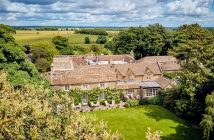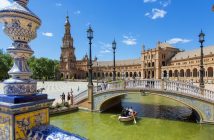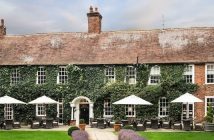I’m deep inside the Forest of Dean – a former royal hunting ground in Herefordshire popular with the Tudors – in search of watery wildlife. It’s a crisp April morning and the sky is piercingly blue. Ancient oaks cloaked in ivy and moss seem sprung from a fairytale. The forest floor is blanketed in bluebells and dog’s mercury. Cherry blossom falls silently like snow. I stop to munch on a lilac cuckooflower – affectionately known as ‘lady’s smock’ – which has the same fiery flavour as wasabi. Having recently relocated from North Africa, blackcaps – the nightingale of the north – are singing in the trees with full-throated ease.
From the corner of her eye, one of our group spots a questing bank vole passing feather-footed through the plashy fen, much to the delight of our guide, Ed Drewitt, an ebullient naturalist with a PhD in peregrines and a limitless passion for all things furry and feathered. I feel like William Boot in Scoop researching his next Lush Places column for The Daily Beast. We’re patiently awaiting the elusive kingfisher. Hopes are high for a sighting, but Ed is doing his best to manage expectations. Binoculars are around necks, tones are hushed and eyes peeled. Ed plays us the sound of the kingfisher’s call, so we know what to look out for. It’s squeaky and high-pitched, and rather at odds with the bird’s regal demeanour.
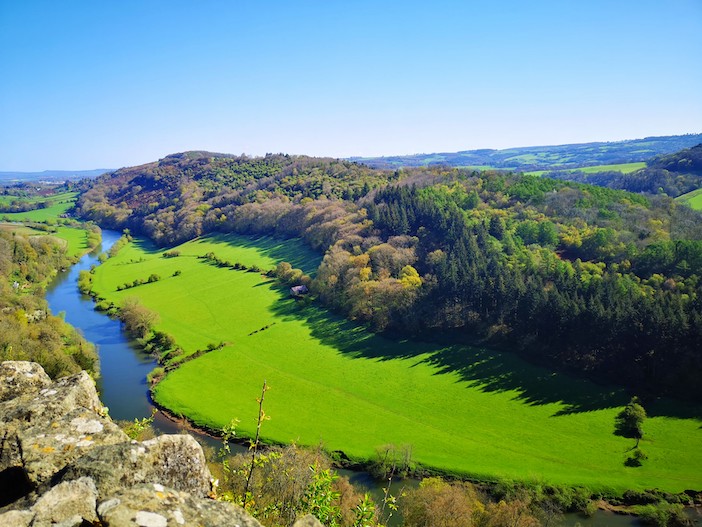
Keen to capitalise on the spring sunshine, Ed takes us up to Symonds Yat Rock. The view from the top is breathtaking. Snaking through the forest, the river Wye glitters in the morning sunlight, moving slowly and languidly like honey off a spoon. The land around it is so vividly green it looks like we’ve stumbled upon Middle Earth. Canada geese nest in the caves off the limestone cliffs and jackdaws circle overhead, their black feathers shining like crude oil in the sun.
Having worked up an appetite, we trek back down through the forest and I feast on wild garlic freshly plucked from the ground. Its assertive allium hit makes my eyes water. In the scenic village of Redwood, Ed points out the bridge that Otis and Eric cycle across in Sex Education, though we fail to pinpoint the show’s iconic red and white chalet nestled high in the Herefordshire hills, where Gillian Anderson teaches Asa Butterfield about the birds and the bees, and instead admire a trio of muntjac deer gracefully grazing on the hillside.
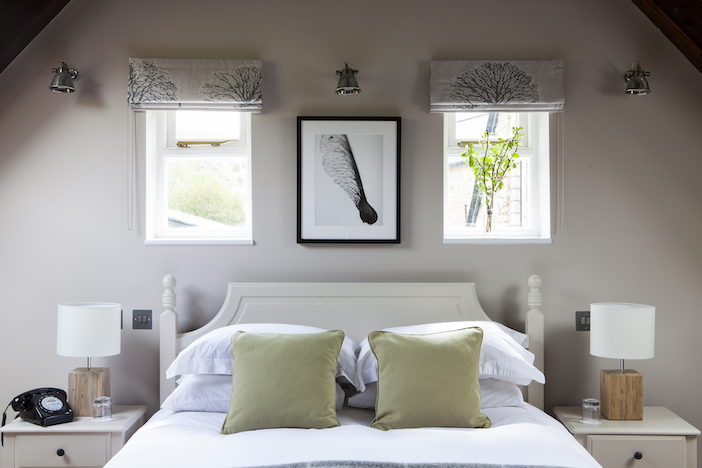
Our abode for the next two nights it the Tudor Farmhouse, a cosy boutique hotel in the village of Clearwell whose rooms are named after birds. Like The Pig and Soho Farmhouse, it’s a masterclass in rustic chic – rooms are painted in tasteful neutral tones and come complete with rolltop baths, monsoon showers and duck feather pillows. Bursting with bergamot, the Bramley pampering products are so good there’s a note in the bathroom politely asking you not to nick them. Wellies in an array of shades are lined up in height order at reception, while pitch forks hang from the walls of the sage green dining room prettified with crimson William Morris curtains adorned with strawberry-snatching birds.
Dinner begins with a Chase Vodka-laced Crumbletini, a nostalgic boozy take on a rhubarb crumble, followed by an invigorating bowl of pond green wild garlic soup and a refreshing starter of cured trout with fennel, radish, blood orange and ricotta. The main event – roasted salt cod with a smoked potato fondant, braised leeks, crispy capers and lemon – is a comforting celebration of the sea that showcases the skill of an accomplished chef. The meal ends on a (sugar) high with an indulgent egg custard tart and the last of the season’s rhubarb, which arrives both poached and in a sorbet.
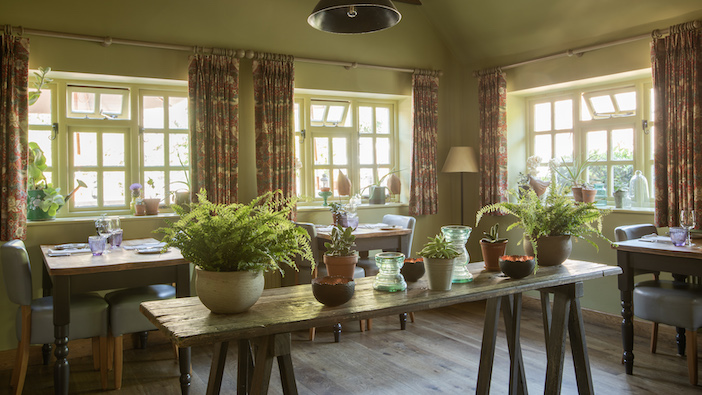
At breakfast, soft light filters through the dining room making the neatly laid table, with its homemade granary bread, freshly churned Wye Valley butter and pots of Welsh marmalade look like a scene from a Dutch still life. We gorge on oaked smoked salmon and scrambled eggs oozing onto pillowy crumpets. Over breakfast Ed explains that we’ve come at the perfect time to enjoy the birdsong in the forest, as the warblers are starting to arrive from Africa, the female birds are beginning to nest and the males protect their territory. What might sound like a charming chorus to us is actually a warning signal to rival males to stay away from their patch. He also regales us with fun bird facts – swallows are surprisingly promiscuous, while male wrens go to great lengths to impress potential mates, building numerous nests to show off their homemaking skills.
Hoping to manifest a kingfisher, I don a pair of turquoise trousers but stop short of orange socks. We head to the RSPB’s Nagshead Reserve where we’re rewarded with aerial acrobatics from male and female redstarts and a fleet of pied flycatchers fresh from their wintering grounds in West Africa. Walking among the towering hemlocks, Ed can barely contain his excitement when he catches sight of a firecrest singing atop a Douglas fir, which swoops close enough to show off an impressive orange mohawk that makes it look like the avian equivalent of Donald Trump.
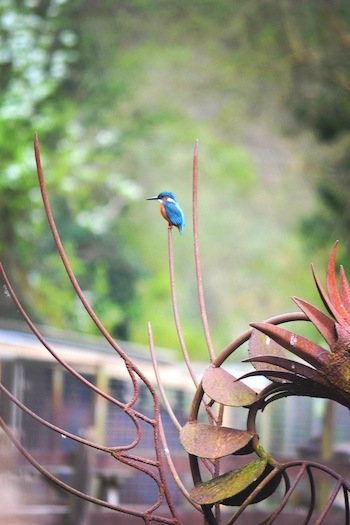 Venturing further into the heath, we’re treated to the spring songs of crossbills, willow warblers and tree pipits, all of which are delightful, but my mind is fixed on the kingfisher. I’ve become obsessed with the idea of seeing one, and the thought of heading home without doing so feels unbearable. I have to remind myself that the retreat is slow travel at its best, and requires patience as nature quietly reveals itself. One final chance of a sighting remains at Soudley Ponds, where we end our avian adventure. It’s a beautiful spot that the Impressionists would have adored, where the water reflects the trees like a mirror.
Venturing further into the heath, we’re treated to the spring songs of crossbills, willow warblers and tree pipits, all of which are delightful, but my mind is fixed on the kingfisher. I’ve become obsessed with the idea of seeing one, and the thought of heading home without doing so feels unbearable. I have to remind myself that the retreat is slow travel at its best, and requires patience as nature quietly reveals itself. One final chance of a sighting remains at Soudley Ponds, where we end our avian adventure. It’s a beautiful spot that the Impressionists would have adored, where the water reflects the trees like a mirror.
Having walked its length we stop to rest before going our separate ways. The mood is quiet and contemplative. We sit in silence willing the bird to appear. It feels like an impossibility, and yet tantalisingly within our grasp. The wait continues. No one speaks. Suddenly, we catch sight of a flash of blue in the middle of the pond and notice a kingfisher perching on a statue. He pauses there for over a minute, posing patiently for pictures.
The apparition feels dream-like and surreal. Cameras click frantically, binoculars swivel into focus, and we all silently marvel at the magnificent creature who has come to pay us a visit, his feathers so brilliantly blue they don’t look made for this world. Having done his duty, he dives into the water, catches a fish and gobbles it up. Seeing a kingfisher up close in exquisite detail is something that will stay with me forever. I’m not sure who was listening, but it was one of those divine moments in life that make you feel like everything is connected and magic forces are in play.
Rates at Tudor Farmhouse start from £129 per night based on two people sharing a hatchling room, which includes a TV, high-speed WIFI, Nespresso coffee machine, mini bar and Bramley bath products. For more information, and for bookings, please visit www.tudorfarmhousehotel.co.uk.


